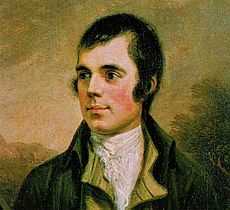To a Mouse
"To a Mouse, on Turning Her Up in Her Nest with the Plough"[1] (Scots: "Tae a Moose") is a Scots poem written by Robert Burns in 1785, and was included in the Kilmarnock volume.[2] According to legend, Burns was ploughing in the fields and accidentally destroyed a mouse's nest that it needed to survive the winter. In fact, Burns' brother had claimed that the poet composed the poem while still holding his plough.[3]
The poem
| Burns' original |
|---|
|
Wee, sleekit, cow'rin, tim'rous beastie, I'm truly sorry man's dominion I doubt na, whyles, but thou may thieve; Thy wee-bit housie, too, in ruin! Thou saw the fields laid bare an' waste, That wee bit heap o' leaves an' stibble, But Mousie, thou art no thy lane, Still thou are blest, compared wi' me! |
In other media
John Steinbeck took the title of his 1937 novel Of Mice and Men from a line contained in the penultimate stanza: "The best laid schemes o' mice an' men / Gang aft agley" (often paraphrased in English as "The best-laid plans of mice and men / Often go awry"). The 1997 novel The Best Laid Plans by Sidney Sheldon also draws its title from this line, and so do the novel of the same name by Canadian author Terry Fallis and the film series based on it.
The first stanza of the poem is read by Ian Anderson in the beginning of the 2007 remaster of "One Brown Mouse" by Jethro Tull. Anderson adds the line "But a mouse is a mouse, for all that," at the end of the stanza, which is a reference to another of Burns's songs, "Is There for Honest Poverty", commonly known as "A Man's a Man for A' That".
The first line is also featured in Michael Morpurgo's "Private Peaceful", as the narrator Tommo remembers learning it in class after seeing a mouse in his trench.
Sharon Olds's poem "Sleekit Cowrin'" also references this poem.
In Douglas Adams's Hitchhikers Guide to the Galaxy series, mice are the physical protrusions into our dimension of a race of hyperintelligent pan-dimensional beings who commissioned construction of the Earth to find the Question to the Ultimate Answer of Life, the Universe, and Everything. When their plans go wrong they lament that "the best laid plans of mice" don't always work out.
The Monty Python sketch 'Word Association' references the first line of the poem, and replaces the simple word "We" with "Wee sleekit cowerin' timorous beastie"[4]
See also
References
- ↑ Burns, Robert, To a Mouse, on Turning Her Up in Her Nest with the Plough, Country.
- ↑ Burns, Robert (1786). "Poems, chiefly in the Scottish dialect". Kilmarnock: John Wilson. p. 138. Retrieved 13 February 2014.
- ↑ Greenblatt, Stephen, ed. The Norton Anthology of English Literature. 9th ed. Vol. D. New York: W.W. Norton, 2012. Print.
- ↑ http://www.montypython.net/scripts/word-ass.php
External links
| Wikisource has original text related to this article: |
- McGown, George William Thompson. A Primer of Burns, Paisley : A. Gardner, 1907. Fully annotated version of To a Mouse, with historical background. pp. 9–20
- Text of the poem can be found at 76. To a Mouse
| |||||||||||||||||||||||||||||
